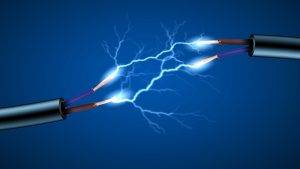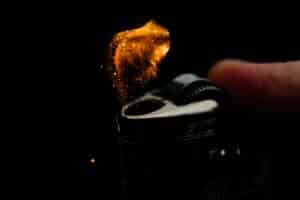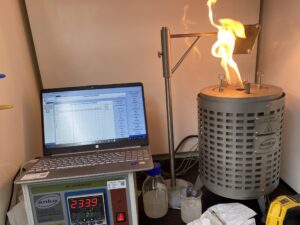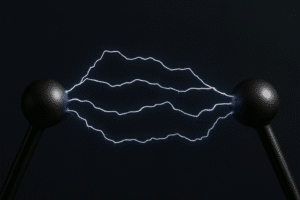We also offer
Electrostatic Charge Transfer Measurement
Electrostatic charge transfer refers to the movement of electric charge between materials or objects through contact or proximity. This exchange causes charge redistribution and potential differences between surfaces due to the movement of electrons. The test measures the charge transferred during electrostatic discharges from insulating surfaces. It is particularly useful for evaluating brush discharges from materials or equipment surfaces and serves as an alternative to assessing discharge energy through flammable gas ignition tests.
Sparks from Isolated Conductors and Insulators
Insulating materials can isolate conductive components or equipment from ground. When close to a charged material, these conductors may become charged through induction, charge sharing, or by collecting sprayed charge or particles.
Such isolated conductors can accumulate significant charge and store energy over time. This energy can eventually be released as a spark discharge to ground, posing ignition hazards.
Igniting Power of Insulators
To determine the direct incendivity of discharges, the insulating material is charged under worst-case conditions—ideally to the highest level possible in practical settings. A discharge is then provoked toward an earthed sphere (ignition probe), and passed through a gas mixture of known minimum ignition energy (MIE). This test is performed according to IEC/TS 60079-32-1.
Isolated conductors and insulators present hazards in flammable atmospheres due to charge retention on or within their surfaces. A range of electrostatic discharge tests—such as charge transfer, igniting power, and spark discharge from isolated conductors and insulators—can support a complete risk assessment for using such materials in hazardous environments.
Testing Principle and Methodology
This test applies to solid insulating materials, not powders. Begin by conditioning the test material at 25% relative humidity for at least 24 hours.
Rub the sample using a material from the positive end of the triboelectric series. Apply at least one stroke per second with medium force (approximately 40 N), in a direction away from the tester. Continue rubbing for 10 ± 1 seconds, ending with a firm stroke.
Grip the sample using insulated holders to avoid unintentional discharge. Carefully lift the sample at least 20 cm from the table, minimizing charge loss.
Quickly discharge the sample by slowly approaching it with a spherical electrode until a spark occurs. Focus on discharging hazardous parts of the sample, such as large surface areas or small conductive features.

Charge Transfer Set up
Applicable Standard
Electrostatic charge transfer testing is conducted in accordance with:
-
IEC 60079-0
-
IEC/TS 60079-32-1
Data Interpretation
Results are interpreted based on the IEC 60079 standard, which includes classifications for explosion groups.
Under IEC 60079-0 and IEC/TS 60079-32-1, insulating materials are subject to maximum allowed surface area limitations in explosive atmospheres. However, in some cases, acceptable safety levels can still be achieved. These include:
-
Surfaces with embedded corona tips
-
Enclosures backed with printed boards
-
Materials with low internal breakdown voltage (a few kilovolts)
By determining the maximum charge transferable from an insulating surface, you can establish the maximum safe surface area for use in explosive environments.
When to Perform Charge Transfer Measurements
Charge transfer testing is recommended when static electricity could pose a hazard during handling, manufacturing, storage, or transport. It is especially important for solid insulating materials with high charge retention and situations where grounding is impractical.
Why Choose Prime Process Safety Center
Prime Process Safety Center is a recognized leader in process safety testing, backed by an ISO/IEC 17025:2017 accredited laboratory experienced laboratory personnel. We are committed to delivering accurate, reliable, and defensible data that aligns with industry and regulatory standards.
-
We specialize in electrostatic testing with proven accuracy and reliability
-
Our lab uses state-of-the-art equipment for precise, sensitive measurements
-
We follow strict testing protocols and quality control measures
-
Our team interprets and analyzes results to offer practical insights and recommendations for your application or research
FAQ
What is Electrostatic Charge Transfer?
Answer: Electrostatic charge transfer refers to the movement or exchange of static electricity between two materials or surfaces, leading to an imbalance in electrical charges and potentially resulting in sparks or electrostatic discharge.
Why is Electrostatic Charge Transfer Significant?
Answer: Understanding charge transfer is crucial as it can lead to static buildup, which, if discharged in sensitive environments or near flammable substances, may cause sparks, fires, explosions, or damage to electronic components.
How is Electrostatic Charge Transfer Measured or Tested?
Answer: Charge transfer is evaluated through various tests measuring the accumulation or dissipation of static charges on materials or surfaces using specialized instruments.
What Factors Influence Electrostatic Charge Transfer?
Answer: Material composition, surface characteristics, environmental conditions (humidity, temperature), movement, and friction between materials are factors that impact the generation and transfer of static electricity.
What Industries or Applications Require Attention to Electrostatic Charge Transfer?
Answer: Industries involving flammable substances, electronics manufacturing, cleanroom environments, powder handling, chemical processing, and transportation of sensitive goods commonly address electrostatic charge transfer to prevent hazards or damage.

















